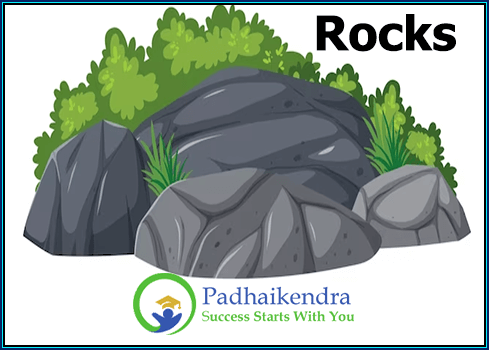Rocks : Rocks are naturally occurring solid materials that are made up of minerals or mineral-like substances. Rocks are often used for construction, as they are durable and readily available. They can also be used for landscaping or as decorative elements, such as in rock gardens or as part of an aquarium.
Types of rocks
Rocks can be classified into three main types based on their origin and formation process: igneous, sedimentary, and metamorphic rocks.
- Igneous Rocks: These rocks are formed from the solidification and cooling of molten magma or lava. Igneous rocks can be further classified into two main types:
- Intrusive igneous rocks: These rocks form when magma cools and solidifies slowly beneath the Earth’s surface, resulting in coarse-grained rocks such as granite and gabbro.
- Extrusive igneous rocks: These rocks form when lava cools and solidifies quickly on the Earth’s surface, resulting in fine-grained rocks such as basalt and rhyolite.
2.Sedimentary Rocks: These rocks are formed from the accumulation and cementation of sediment particles such as sand, clay, and organic matter. Sedimentary rocks can be further classified into three main types:
- Clastic sedimentary rocks: These rocks are formed from the accumulation and lithification of loose sediment particles, resulting in rocks such as sandstone, shale, and conglomerate.
- Chemical sedimentary rocks: These rocks are formed from the precipitation of dissolved minerals, resulting in rocks such as limestone, dolomite, and chert.
- Organic sedimentary rocks: These rocks are formed from the accumulation and lithification of organic matter, resulting in rocks such as coal and oil shale.
3.Metamorphic Rocks: These rocks are formed from the transformation of pre-existing rocks under high pressure, temperature, and/or chemical conditions. Metamorphic rocks can be further classified into two main types:
- Foliated metamorphic rocks: These rocks have a layered or banded appearance due to the alignment of minerals under pressure, resulting in rocks such as slate, schist, and gneiss.
- Non-foliated metamorphic rocks: These rocks do not have a layered or banded appearance, and are formed from the recrystallization of minerals under high temperature and pressure, resulting in rocks such as marble and quartzite.
Each type of rock has unique properties and characteristics that can provide important information about the geological history and processes that formed it.





